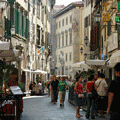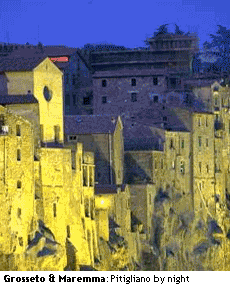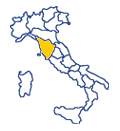
Grosseto & Maremma Hotels

Reserve Grosseto & Maremma Hotels: save up 70% on rooms!
Compare offers & book on line at hotel's web sites. |
|

|
|
Grosseto & Maremma Guide Italy
Saturnia hot springs and the Tufa Towns
|
|
|
|
|
Saturnia hot springs and the Tufa Towns
This itinerary covers the interior of the Maremma, an area still unknown to mass tourism, that will allow you to capture the mysterious heart of its appeal. The traveler feels as if he has entered an enchanted land populated by fairies, wizards and brigands, where you will be strongly tempted to wander without a precise goal, letting yourself be carried away by the emotions of the landscape. You will visit the great Etruscan necropolises and medieval cities like Pitigliano, Sovana and Sorano, which seem to have grown from the very rock on which they stand. You will soak in the hot waters of Saturnia.
The itinerary can be covered in two days, but it's worth staying longer to explore the territory through fascinating trekking on food, mountain bike or horseback. You can select from hotels in Saturnia, hotels in Pitigliano and hotels in Sorano for a stay characterized by relaxation and charm. Those who prefer a different type of lodging will be able to choose from comfortable bed & breakfasts and Maremma holiday farms in ancient villages or the open countryside.
MANCIANO is a town in a scenic location that has been nicknamed the “spy of the Maremma” because from here you can see the surrounding territory in every direction. Inside its walls, the village has narrow little streets that follow an elliptical route. The top of the hill is dominated by a castle with an imposing tower. Nearby, you will find the Museo di Preistoria e Protostoria, which documents the rich Pre-Etruscan period of this region, from the Paleolithic to the Bronze Age, with many archeological finds on display. Near Manciano, don't miss an opportunity to visit the town of Montemerano, an authentic medieval jewel constructed on a hill covered with olive trees. You will be enchanted by the poetry of this village, which surrounds its castle and is enclosed by a wall. Visit the Romanesque-Gothic Church of San Giorgio that contains precious frescoes and works of art, including a polyptych painted by Sano di Pietro in 1458.
SATURNIA is a city of mysterious origins that, according to legend, was founded by the god Saturn. In the Middle Ages, it was completely destroyed by Siena because it was considered a center of conspirators. Today, its fame is linked to the nearby Saturnia Hot Springs, whose sulfurous waters gush all year round at a temperature of 37.5°. In the Middle Ages, these springs were the source of disturbing legends: the place was the meeting place of wizards and witches, magic spells and witches' sabbaths and it was said that this was the devil's doorway from hell. The waters were thought to be bewitched because they gave off a strong satanic odor (sulphur). The springs are divided between two sites: the enchanting natural pools with waterfalls where access is free and you can always bath; the Terme di Saturnia Spa Resort complex, an oasis of relaxation with four open-air hot spring swimming pools, waterfalls, hydromassage and mud treatments.
SOVANA, the ancient capital of the Aldobrandeschi, seems to be a corner frozen in a remote age, rich with history and artistic beauty that creates an deep and unforgettable impression. Sovana was one of the principal Etruscan cities and was reborn in the Middle Ages when it became the property of the Aldobrandeschi family. During this period, Pope Gregory VII was born here. Its splendor lasted until about 1300, when it began a slow decline that lead to its complete abandonment in the 19th century. The village has been reborn in the last ten years, thanks to the discovery of the great Etruscan necropolis and, today, is a favorite destination of academics and tourists.
Once you have crossed the threshold of the Rocca Aldobrandesca, you can continue on to Piazza del Pretorio, which has several lovely buildings, such as the Church of Santa Maria, dating from the late Romanesque period, the Palazzo dell’Archivio, with its strange clock, and, facing the church, the Palazzo della Loggia and the Palazzo Pretorio. The latter houses a small, but interesting, museum of the area's history and archeology.
In the immediate vicinity, you will find the fascinating Sovana Necropolis, with many tombs of various types. Don't miss the Necropolis of Poggio Felceto, where you will find a complex of spectacular tombs including the Tomb of Hildebrand, the masterpiece of all Etruscan burial places. In Sovana, you can also experience a walk in the enchanting “Vie Cave”, imposing walkways excavated from the tufa by the Etruscans, perhaps as communication lanes, perhaps for magic rites. Among the best known is the “Cavone,” with tombs cut into the rock and inscriptions.
PITIGLIANO Constructed on a spur of tufa below the imposing Orisini castle, Pitigliano appears to the visitor like a scene from a fable, rising on a rocky cliff of savage beauty surrounded by deep valleys. The houses are constructed at the top of sheer tufa cliffs that make the construction of defensive walls superfluous. There are characteristic grottos and Etruscan tombs excavated from the high tufa walls, some of which are used today as cellars for the preservation of wine.
Entering the city on foot, you immediately find yourself before the Fortezza Orsini, which has preserved its original 16th-century appearance. Inside, you will find the Diocesan Museum of Sacred Art, which we recommend visiting because it will allow you to see the sumptuous interiors of the palazzo. Also of interest are the 18th century Cathedral and Church of Santa Maria, but Pitigliano's magic is best savored by walking along the old streets and, especially, visiting the famous Jewish Quarter. Since the 16th century, Pitigliano has been the home of a thriving Jewish community; today, you can visit the Synagogue, cemetery, library and the oven where unleavened bread was baked. The Synagogue dates from 1598 and was renovated in the middle of the 18th century. A renovation in 1995 rediscovered its ancient classic expression. The ritual Torciata di San Giuseppe takes place in Pitigliano every 19 March.
SORANO The village is constructed from dark tufa and is one piece with the rock on which it rises, dominated by a high fortress that time has made to resemble a natural peak. Of Etruscan, and later Roman, origin, it was a possession of the Aldobrandeschi and then, from 1312 on, of the Orsini, who gave it its current appearance and build the walls and mighty fortress that made it one of the strongest defenses of the Earldom of Pitigliano.
The best thing is to walk along its narrow lanes observing the structure of the houses until you come to the Fortezza Orsini an impregnable fortification that, by following its underground walkways, also provides an understanding of many aspects of renaissance military life. In town, you can also visit the Church of San Nicola and "il Cortilone," a huge granary built by the Orsini in 1554.
There is a lovely excursion from Sorano to Vitozza, in the hamlet of San Quirico, one of the largest rock settlements in central Italy, with over 200 grottoes that were inhabited from prehistory until the Middle Ages. Along the path that runs along the site, you can see the remains of three fortresses, the Church of Sant'Angelo and an important Roman "columbarium," all in an uncontaminated environment.
Photos courtesy of: Agenzia Turismo della Maremma & Municipality of Grosseto
Go to directories of the Web Sites
|
|
|
|
|
Acquista la tua visibilità su Travel Plan
|
|
|
|





